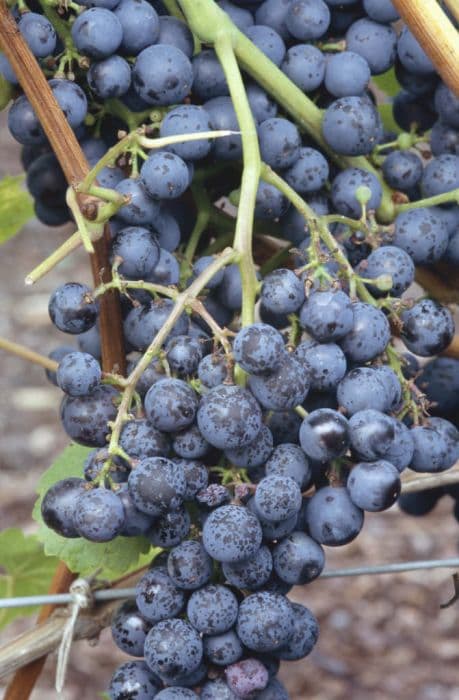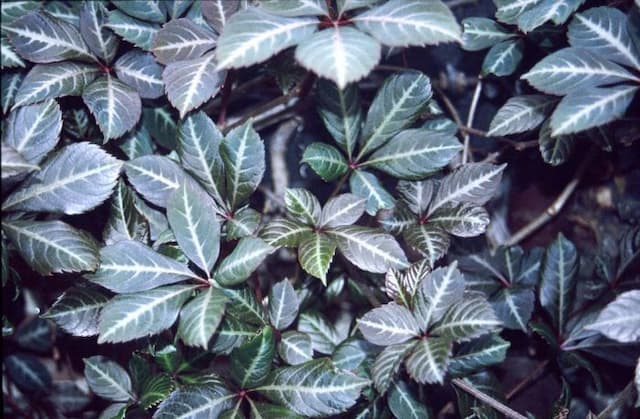Brant Grapevine Vitis 'Brant' (O/b)

ABOUT
The Vitis 'Brant' is a type of grapevine known for its ornamental features and fruit production. This deciduous plant has climbing tendrils, allowing it to grow upwards and spread with the support of structures such as trellises or fences. It boasts large, lobed leaves that are generally deep green in color. During the growing season, these leaves provide a dense, leafy canopy. The grapevine blooms with inconspicuous flowers which later develop into clusters of grapes. The grapes produced are typically small, with a blue-black hue, and are enjoyed both by wildlife and humans for their sweet taste when ripe. The bark of the grapevine is also of interest, as it becomes textured and gnarled with age, adding to the plant's aesthetic. The seasonal changes bring about a transformation in the foliage, with leaves turning vibrant colors such as reds and purples in the autumn before they drop, signaling the end of the growing season.
About this plant
 Names
NamesSynonyms
Brant Grape, Ornamental Grape
Common names
Vitis vinifera 'Brant'.
 Toxicity
ToxicityTo humans
Grape 'Brant' is not toxic to humans when ingested in normal food quantities. However, all parts of the plant excluding the ripe grape fruit can contain compounds that are harmful when consumed in large amounts. Grape leaves, stems, and seeds might have high levels of tannins and other compounds that can cause stomach upset when ingested in large quantities. Moreover, grape vines can have sap that may cause skin irritation upon contact in sensitive individuals. In general, it is recommended to eat only the ripe fruit and to consult a medical professional if any adverse effects occur after consuming plant parts other than the grapes.
To pets
Grape 'Brant' is toxic to pets, especially dogs. Ingesting even small quantities of grapes can cause acute kidney failure in dogs. Symptoms of grape or raisin toxicity can include vomiting, diarrhea, lethargy, loss of appetite, abdominal pain, and sudden onset of kidney failure which can be indicated by a decrease in urine production. The exact toxic substance in grapes is unknown, but all parts of the grape plant, including the vines, leaves, and stems, should be considered potentially dangerous as well. If a pet has ingested grapes or any part of a grape vine, immediate veterinary attention is crucial.
 Characteristics
CharacteristicsLife cycle
Perennials
Foliage type
Deciduous
Color of leaves
Green
Flower color
Greenish-yellow
Height
10-15 feet (3-4.5 meters)
Spread
10-15 feet (3-4.5 meters)
Plant type
Climber
Hardiness zones
5-9
Native area
Europe
Benefits
 General Benefits
General Benefits- Aesthetic Appeal: Vitis 'Brant' adds visual interest to gardens with its attractive leaves and dark purple grapes.
- Wildlife Attraction: The grapes serve as a food source for birds and other wildlife, promoting biodiversity.
- Shade Provider: Its dense foliage offers a natural canopy, creating shaded areas in gardens or over pergolas.
- Erosion Control: The plant's vigorous rooting system helps stabilize soil and prevent erosion on slopes.
- Screening Plant: It can serve as a living screen, offering privacy and reducing noise levels when planted along fences or walls.
- Edible Fruit: The grapes can be eaten fresh, used in cooking, or made into wine, providing a source of homegrown food.
- Seasonal Interest: This vine exhibits seasonal changes from vibrant green leaves in the spring to colorful foliage in the autumn.
 Medical Properties
Medical Properties- Antioxidant: Vitis 'Brant' contains compounds such as resveratrol, which have antioxidant properties that can help protect cells from damage.
- Cardiovascular health: Resveratrol and other polyphenolic compounds found in Vitis 'Brant' may contribute to improved heart health by reducing inflammation and improving blood lipid profiles.
- Anti-inflammatory: The plant's components may offer anti-inflammatory benefits, potentially beneficial for reducing the risk of certain chronic diseases.
- Antimicrobial: Vitis 'Brant' extracts may have antimicrobial effects against certain pathogens, contributing to the treatment or prevention of infections.
 Air-purifying Qualities
Air-purifying QualitiesThis plant is not specifically known for air purifying qualities.
 Other Uses
Other Uses- Photography Prop: Vines of Vitis 'Brant' can be employed as natural backdrops or props for photographers looking for a rustic or autumnal aesthetic.
- Handicraft Material: The pliable canes can be woven into baskets, wreaths, or other decorative items.
- Shade Provider: The dense foliage can be trained over pergolas or trellises to create shaded outdoor areas.
- Natural Fencing: When planted in rows, the vine can form a living fence for privacy or as a boundary marker.
- Noise Reduction: Thick plantings of this vine can help dampen traffic noise or neighborhood sounds in urban gardens.
- Soil Erosion Control: The strong root system of the vine can help stabilize soil on slopes or banks, preventing erosion.
- Educational Resource: It can be used in schools or educational programs to teach about plant growth, vine training, or the lifecycle of plants.
- Art Inspiration: Artists may use the vine's growth patterns or leaf shapes as inspiration for paintings, drawings, or sculptures.
- Culinary Decoration: Fresh or dried leaves can be used as a natural garnish for plating dishes in restaurants or culinary presentations.
- Wildlife Habitat: The vine can provide shelter and nesting sites for birds, as well as food for wildlife in the form of its berries.
Interesting Facts
 Feng Shui
Feng ShuiThe plant Grapevine is not used in Feng Shui practice.
 Zodiac Sign Compitability
Zodiac Sign CompitabilityThe Grapevine is not used in astrology practice.
 Plant Symbolism
Plant Symbolism- Fertility: Vines are often associated with growth and proliferation, making the Vitis 'Brant' symbolize fertility and the potential for new endeavors.
- Connection: As vines connect themselves to various structures, this plant can symbolize the connections between people or ideas.
- Vitality: Given the vine's ability to thrive in various conditions, it represents life, energy, and robust health.
- Transformation: Because vines can adapt and transform their surroundings, the Vitis 'Brant' is associated with change and adaptability.
- Timelessness: As perennial plants, vines symbolize endurance and the continuation of life through seasons, thus representing timelessness.
- Creation: Grapevines, in particular, are linked with wine production, which is often equated with creativity and the cultural aspect of creation.
 Water
WaterThe Ornamental Grape Vine requires regular watering to establish a strong root system, particularly during its first growing season. It should ideally be watered deeply once a week, which may translate to about 1-2 gallons per plant, depending on the soil type and weather conditions. During hot or dry periods, watering frequency should be increased to prevent stress. In subsequent years, the vine is more drought-tolerant, but consistent moisture is important for the best growth and fruit production. Always ensure the soil is moist but not waterlogged.
 Light
LightOrnamental Grape Vines thrive in full sun, needing at least six hours of direct sunlight daily for optimum growth and fruit production. They should be planted in a spot where they are exposed to direct sunlight for the majority of the day to ensure they receive the energy needed for photosynthesis and to maintain healthy foliage.
 Temperature
TemperatureOrnamental Grape Vines are hardy and can survive in a wide temperature range. They prefer temperatures between 55-85 degrees Fahrenheit for active growth. They can withstand winter dormancy temperatures as low as 20 degrees Fahrenheit. The ideal growing conditions are warm days and cool nights, which help in the development of sugars in the grapes.
 Pruning
PruningPruning is essential for the Ornamental Grape Vine to maintain plant health, shape, and to maximize fruit production. It should be pruned in late winter when the plant is dormant, removing dead or diseased wood and thinning out crowded areas to ensure good air circulation. Prune again after fruiting to remove spent fruit clusters and any overly vigorous shoots that may sap energy from fruit production.
 Cleaning
CleaningAs needed
 Soil
SoilThe best soil mix for Ornamental Grape 'Brant' is well-draining loam with compost. Soil pH should be slightly acidic to neutral, around 5.5 to 7.0.
 Repotting
RepottingOrnamental Grape 'Brant' vines are typically grown outdoors and do not require regular repotting.
 Humidity & Misting
Humidity & MistingOrnamental Grape 'Brant' is tolerant of a range of humidity levels and thrives with ambient outdoor humidity.
 Suitable locations
Suitable locationsIndoor
Use large pots, ample sunlight, prune to manage size.
Outdoor
Full sun, sturdy support for climbing, ample space to grow.
Hardiness zone
5-9 USDA
 Life cycle
Life cycleVitis 'Brant', commonly known as 'Brant's Grape', begins its life cycle as a dormant vine with buds that burst into growth in early spring when temperatures rise. The buds develop into shoots that bear leaves and, if the plant is old enough, clusters of flowers. These flowers are pollinated and develop into bunches of grapes through the summer months. As the grapes mature, they change color and accumulate sugars, reaching full ripeness by late summer to early fall. After harvest, or if unpicked, the grapes will eventually wither, and the vine's leaves turn vibrant colors and fall off as the plant enters dormancy in preparation for winter. With the arrival of the next spring, the cycle starts anew with the breaking of buds.
 Propogation
PropogationPropogation time
Spring-Early Summer
The most popular method of propagation for the grapevine 'Brant', which is a cultivar of Vitis, is through hardwood cuttings. This is best done in late winter when the plant is dormant. A mature, well-ripened cane from the previous season's growth is selected and cut into sections of about 12 to 18 inches (approximately 30 to 45 centimeters), ensuring that each cutting has at least two to three buds. The bottom cut of each section is made just below a bud, and the top cut is made about 1 to 2 inches (2.5 to 5 centimeters) above a bud. The cuttings can then be planted in well-drained soil with the bottom two-thirds of the cutting buried and one-third above the soil surface, with the top bud exposed to air. This method is particularly effective, as it allows the cutting to develop its own root system over time, eventually growing into a new grapevine that is genetically identical to the 'Brant' parent plant.









